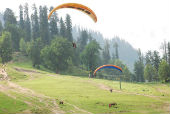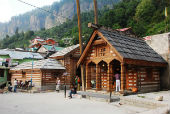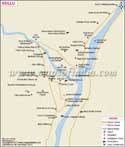Geography:
The town is located at 32°10'N 77°06'E. The town is located at a height of 6,398 ft.Demographics:
The town of Manali has a cosmopolitan culture as people from all over India have settled here. 64% of the inhabitants are males while 36% are females. The average literacy percentage of the town is 74% which is far higher than the overall national average of 59.5%. Categorically the male literacy percentage is 80% while the female literacy rate is 63%.Climate:
Manali has a predominantly cold climate. During the summers even the climate is somewhat cool. Round the year, the temperature is in the range of 4 degree centigrade to 30 degree centigrade. During summer, the standard temperature ranges between 14 degree centigrade and 20 degree centigrade and in the winters, the temperature is in the range of -7 degree centigrade to 10 degree centigrade. Rainfall varies between 24 mm (0.94 in) in the month of November to 415 mm (16.3 in) in the month of July. On average terms some 45 mm of rainfall is expected in the winter and spring. It increases to around 115 mm in the summer months. The total annual rain on an average is 1,520 mm. Around 15 years back, there used to be snowfall in Manali, a prime attraction for the tourists in the months of December. Over the last decade or so, the snowfall in the region takes place in January or February.Etymology:
The name Manali has been given with regards to the Brahmin lawmaker Manu, who defined the laws of Manu, the earliest work of the "Dharmasastra", the textual tradition of Hinduism. Manali exactly means "the abode of Manu". The Manali is also known as the "Valley of the Gods".History:
The valley was mostly inhabitated by rakshas or nomadic hunters in the past times. The next natives of the place were the shepherds from Kangra Valley who took up agriculture as their main occupation. "Naur" or the "nar", one of the exclusive castes to be found in the Kullu valley are one of the earliest natives of the region. Apple trees which were not among the native flora of the region were brought to the place by the British. Plum, pear along with apple is one of the most cultivated fruits in the region and thus a good source of income to the agriculturists.Tourism in Manali:
Manali is a major tourist destination and is one of the most popular hill stations among the tourists. The tourism in the region increased specially since the 1980s after the ascend in the terrorism activities in the neighboring Kashmir. Visitors to Manali contribute to nearly one fourth of the total tourists that visit the State of Himachal Pradesh.du mythology Manu is believed to be the universal law giver. He was the only survivor of a natural calamity and the whole human race was fathered by him. The beautiful hill station of Manali still maintains its mystic charm in the environs.
On your first visit to Manali of Himachal Pradesh you are bound to be enchanted by the calm and serene ambiance created by the marriage of the River Beas, the green Himalayan valleys and the colorful apple orchards. You can enjoy the vibrant mood of the local people in the several Hindu temples and of course in the market place.
In Manali the beauty of the Kullu Valley and the Rothang Pass can be rediscovered if you go for some adventurous activity like River Rafting or Heli Skiing.
The heaven like natural beauty of Manali has earned it the title of the "Valley of the Gods".
Last Updated on : November 13, 2025
| Manali Tour |
 |
 |
 |
| Apple Orchards | Beas River | Hidimba Devi Temple |
 |
 |
 |
| Museum of Himachal Culture and Folk Art | Nature Park | Old Manali |
 |
 |
 |
| Rohtang Pass | Adventure Sports at Solang Nala | Solang Nala from Manali |
 |
||
| Vashisht Temple |
Manali Tourism










